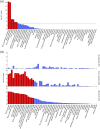Association between 25(OH) vitamin D and schizophrenia: shared genetic correlation, pleiotropy, and causality
- PMID: 39734669
- PMCID: PMC11671254
- DOI: 10.3389/fnut.2024.1415132
Association between 25(OH) vitamin D and schizophrenia: shared genetic correlation, pleiotropy, and causality
Abstract
Background: This study delves into the complex interplay between genetics, 25-hydroxyvitamin D (25OHD), and schizophrenia (SCZ). It leverages extensive sample data derived from Genome-Wide Association Studies (GWAS) to uncover genetic correlations.
Methods: Employing Linkage Disequilibrium Score Regression (LDSC) and S-LDSC, this study investigates genetic connections between 25OHD and SCZ. It examines Single Nucleotide Polymorphism (SNP) heritability in specific tissues and incorporates diverse immune cell datasets for genetic enrichment analysis. Local genetic correlations were analyzed using HESS software, and pleiotropy analysis identified shared genetic loci in brain tissues. Hyprcoloc analysis was used to explore shared genetic factors between 25OHD, immune cells, and SCZ, complemented by a bidirectional Mendelian Randomization (MR) to probe potential causal links.
Results: We identified a significant negative genetic correlation between 25OHD levels and SCZ. PLACO analysis revealed 35 pleiotropic loci with strong enrichment in brain regions, particularly the cerebellum, frontal cortex, and hippocampus. Eight loci (1p34.2, 2p23.3, 3p21.1, 5q31.2, 12q23.2, 14q32.33, 16p13.3, and 16q24.3) exhibited strong colocalization, highlighting potential drug targets. Gene and tissue enrichment analyses emphasized neurological and immune-related mechanisms, including hyaluronan metabolism. Bidirectional MR analysis supported a causal effect of SCZ on 25OHD levels.
Conclusion: Our study identifies NEK4 as a potential therapeutic target and highlights the involvement of hyaluronan metabolism in the genetic association between 25OHD and SCZ. These findings provide valuable insights into shared genetic pathways, immune-related connections, and causal interactions in the context of SCZ.
Keywords: Mendelian randomization; genetic overlap; genome-wide association study; schizophrenia; vitamin D.
Copyright © 2024 Rong, Li, Lu, Su and Jin.
Conflict of interest statement
The authors declare that the research was conducted in the absence of any commercial or financial relationships that could be construed as a potential conflict of interest. The reviewer Y-QY declared a shared parent affiliation with the author H-ML to the handling editor at the time of review.
Figures





Similar articles
-
Association between 25(OH) vitamin D and multiple sclerosis: cohort, shared genetics, and Causality.Nutr J. 2024 Nov 30;23(1):151. doi: 10.1186/s12937-024-01059-4. Nutr J. 2024. PMID: 39616386 Free PMC article.
-
The role of the brain-bone axis in skeletal degenerative diseases and psychiatric disorders, A genome-wide pleiotropic analysis.Prog Neuropsychopharmacol Biol Psychiatry. 2025 Jun 20;139:111388. doi: 10.1016/j.pnpbp.2025.111388. Epub 2025 May 15. Prog Neuropsychopharmacol Biol Psychiatry. 2025. PMID: 40340016 Review.
-
The shared genetic etiology of antisocial behavior and psychiatric disorders: Insights from pleiotropy and causality analysis.J Affect Disord. 2024 Nov 15;365:534-541. doi: 10.1016/j.jad.2024.08.149. Epub 2024 Aug 24. J Affect Disord. 2024. PMID: 39187189
-
Shared genetic links between hypothyroidism and psychiatric disorders: evidence from a comprehensive genetic analysis.Front Endocrinol (Lausanne). 2024 Jun 6;15:1370019. doi: 10.3389/fendo.2024.1370019. eCollection 2024. Front Endocrinol (Lausanne). 2024. PMID: 38904036 Free PMC article.
-
Phenome-wide Mendelian randomization study evaluating the association of circulating vitamin D with complex diseases.Front Nutr. 2023 Mar 29;10:1108477. doi: 10.3389/fnut.2023.1108477. eCollection 2023. Front Nutr. 2023. PMID: 37063319 Free PMC article. Review.
References
LinkOut - more resources
Full Text Sources

